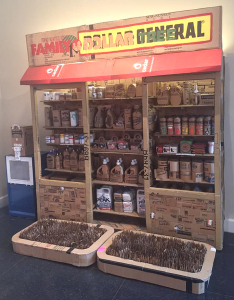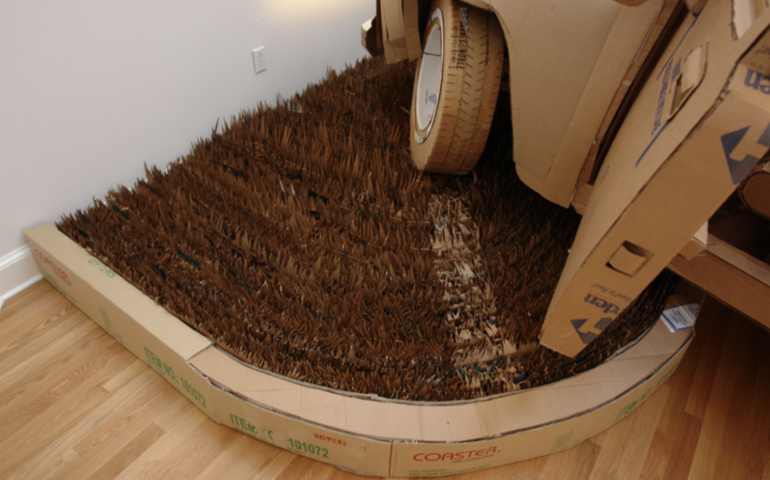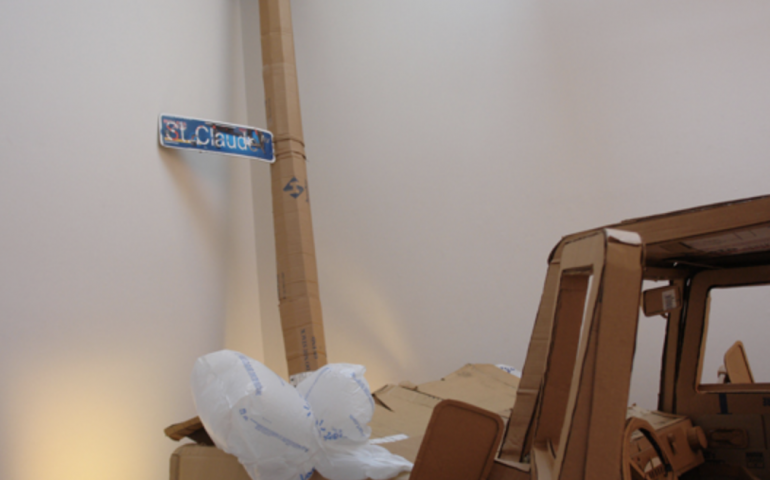Bob Snead is among the dozens of artists represented in Pride of Place: The Making of Contemporary Art in New Orleans, an exhibition of more than 70 works of art donated to NOMA by renowned New Orleans’ gallerist Arthur Roger. Snead’s Family Dollar General Tree represents the type of small-scale “big box” stores that have proliferated across America. It is created entirely of cardboard boxes salvaged from these stores and emblazoned with the logos of the crated goods. With meticulous detail, Snead has manufactured replica merchandise from this refuse cardboard that line the shelves—everything from Little Debbie snack cakes and Tide laundry detergent to Quaker Oats and canned Eckrich Honey Ham. Viewers are encouraged to participate in the installation by way of writing a “love letter” to their favorite brand product, which Snead elaborates upon in this interview with Arts Quarterly Editor David Johnson. Snead will lead an Artist Perspective lecture on Friday, July 21, at 6 p.m. as part of Friday Nights at NOMA programming.
How did you emerge as an artist?
I grew up in Charleston, South Carolina. I went to the college of Charleston and, during that time in undergrad, was really active with a lot of other students. We started an art center in Charleston called Redux Contemporary Art Center, and that’s still going today. I went off to graduate school at Yale for painting, and did that for two years. Then I hit the road with an artist collective and traveled North American roads for two years in a decommissioned transit bus that ran on waste vegetable oil. As we were doing that project, we passed through New Orleans a couple times and ended up crash landing here. I really fell in love with the city.
You have said in the past that you literally witnessed a crash when you arrived in New Orleans. Tell me about that and how it inspired your first installation work in the city.
I was shopping different apartments along St. Claude Avenue and along the major thoroughfares here are just stop signs and light poles—I noticed many are damaged from people who are running into these stationary objects all the time, more than in any other city I’ve visited. I was touring this apartment that we ended up moving into on St. Claude, and we hear this crazy wreck outside, and so we walked out and there’s this truck that had just careened into one of the light poles. It was a completely clear day. There was no weather that was causing this. So, once we moved here, I transformed our front room of the apartment into a re-creation of that wreck, using all of the moving boxes from our move, because it really was this metaphor for our “crash landing” here. We had no plan, and our move did feel like sort of an abrupt crash into a light pole. (See images below.)
We didn’t have a traditional gallery space. The space that we had moved into was an old corner shop space, with the cutoff corner, and it was at St. Claude and Congress. Initially, it was very ad hoc. We were living there and running my wife Dawn’s bakery and my studio, because we had zero money. Dawn was doing pastries and delivering them to coffee shops around the city, and that was sort of how she got started, and then started doing wedding cakes, and then kind of grew into the business that it is now, and we were able to purchase a building. It’s funny, because I moved here seven years ago, and seven years ago, we were like washing our clothes in our bathtub. We were super broke. We’re in a totally different space now.
Was that the first time you had really used cardboard boxes as a medium?
Yes. I’m primarily a painter. I’d started using those boxes and really fell in love with the material, similar to how Tom Sachs loves plywood; I really fell in love with cardboard in a very similar way. With all of the attributes, you can manipulate it in so many different ways, while it’s still a very strong material. In that process, I really discovered how much branding and corporate icons are all over the cardboard that you really just don’t pay attention to. So I started creating some of the products out of the cardboard from that, and that kind of grew into the dollar-store project that you see here at NOMA.
Arthur Roger ultimately took notice of your dollar store project. How did that come about?
I had started working on that project, and then I did a group show at Jonathan Ferrara Gallery with some of the dollar-store cardboard stuff. Arthur purchased a few pieces from that project. It had taken me a few years to really develop the project, and I ended up doing an install of it at May Gallery, when it was in the Bywater area, and then did another install of it at this thing called ArtFields in South Carolina. After that install, Arthur asked me to be a part of his booth at Art Basel Miami, and do a duet for the install there.
I won the jury prize at ArtFields for that project, but it was a purchase award, so they took that whole iteration of the store. So then I had something like six months to recreate something that originally took like two years. I ended up hiring a group of former students of mine to help me recreate it. We created a very inefficient supply chain and started developing ways of reproducing the products out of cardboard that I think was pretty idiosyncratic. We’d never be able to translate that knowledge into any other field.
When we did the initial install for Art Basel, it felt like a Hail Mary throw, because we had worked on it for like six months straight. The crew that was helping me do that, they were also helping me remodel the building that now serves as my wife’s bakery—and our house—that we are now in. We were spending part of our time working on the dollar store and then part of our time working on the house.
What is your underlying message with Family Dollar General Tree?
It’s a mashup of the three major dollar stores, some of which have now merged together even though they’re under different names. What I was really interested in with this project is just how much waste is created with these sort of efficient supply chains that we rely on—and this could be at any kind of store that we shop at. It doesn’t necessarily have to be a dollar store—it’s just at the dollar stores, there’s a lot more. There’s just this tremendous amount of waste that operates in the background that no one really sees, and I wanted to figure out a way to create a project that is the creation eating itself, in a way, to bring light to that waste.
Dollar Stores have exploded over the last decade. There’ve been more dollar stores per capita in all of the major cities than any other store created, and it has a lot to do with the downturn in the economy. It’s going to be interesting, now that we’re on the supposed upswing, where they’re going to go. It feels like they’re here to stay, that they’re now this part of our everyday where they weren’t before. In some cities they’ve replaced grocery stores, so you have Dollar General, now they have the Dollar General Market, that’s like the grocery-store hybrid. I know in our neighborhood, in the Bywater, the dollar stores, those are the grocery stores that exist outside of the bodegas.
How did you initially meet Arthur Roger? You obviously went to a major internationally-renowned exhibition, Art Basel, thanks to him.
I also run an art space on St. Claude called Antenna. Arthur frequents our space, and my first interactions with him were there, with him coming into the space and checking out a show. We moved into this beautiful remodeled space, and we had a show of David R. Harper, who’s this sculptor from Canada, and Arthur came in and bought something like three pieces. He’s been super supportive ever since I’ve interacted with him. I think that he, more than any of the other gallerists in town, really sees the value in the overall community … I think a lot of the other gallerists just don’t have that same kind of feeling in terms of the support of everyone. He values all of it, from his support in NOMA to the outlying arts community. He bridges everything; he and aims for that.
Family Dollar General Tree encourages the viewer’s participation. How did this concept come about?
The NOMA staff asked me to come up with some sort of participatory element for that space, and it took me a few iterations to figure out something. I came up with this idea of “Love letters to Little Debbie,” which is really like love letters to your favorite products. I think New Orleans is one of those cities that loves the things that don’t exist just as much as the things that do. I’m looking forward to seeing what people write with this, particularly locals. Because you think about products like Hubig’s Pies, for instance, that’s one that I thought about immediately because people have this fascination with it now that it no longer exists. There is this affinity for that product. I’m looking forward to seeing what people come up with. As much as this project is about the waste that is created with dollar stores and with efficient supply chains, it’s also really about a love for the shapes of products, for the products themselves. I think that there’s a love/hate theme with this project.


